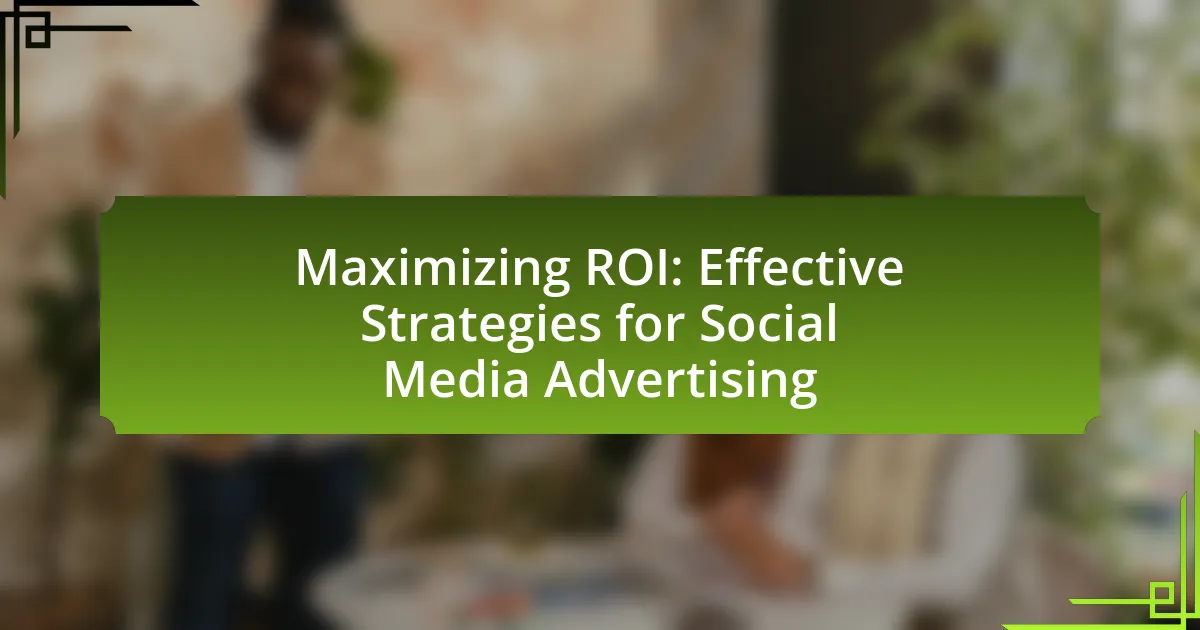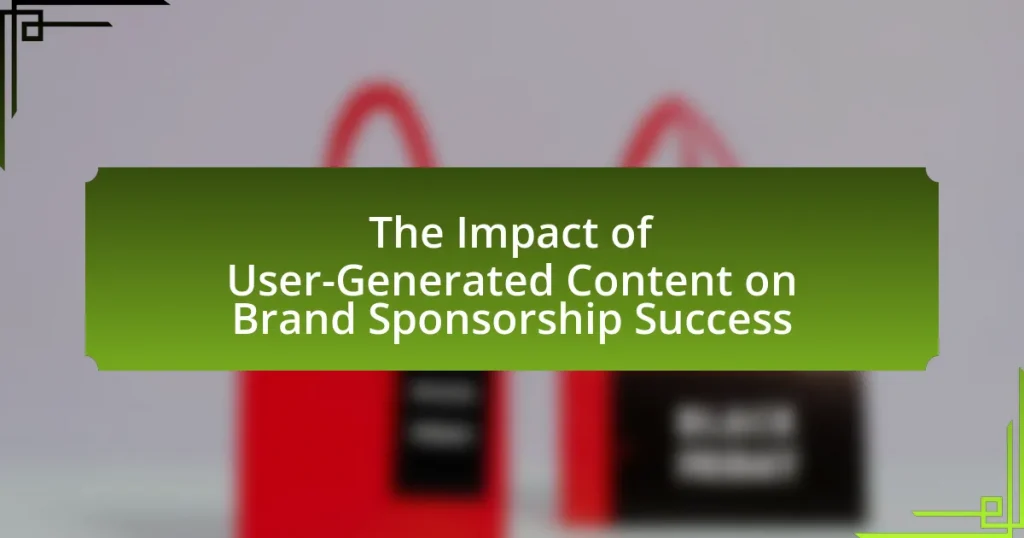Maximizing ROI in social media advertising is the process of enhancing the return on investment from advertising campaigns on social media platforms through optimized ad spend, precise audience targeting, and performance measurement. The article outlines how ROI is calculated, essential metrics for evaluation, and the impact of different platforms on ROI outcomes. It emphasizes the importance of maximizing ROI for business profitability and sustainability, discusses effective strategies such as audience segmentation and content quality, and highlights common pitfalls to avoid. Additionally, it provides insights into the role of A/B testing and key performance indicators that should be monitored to improve advertising effectiveness and overall financial returns.
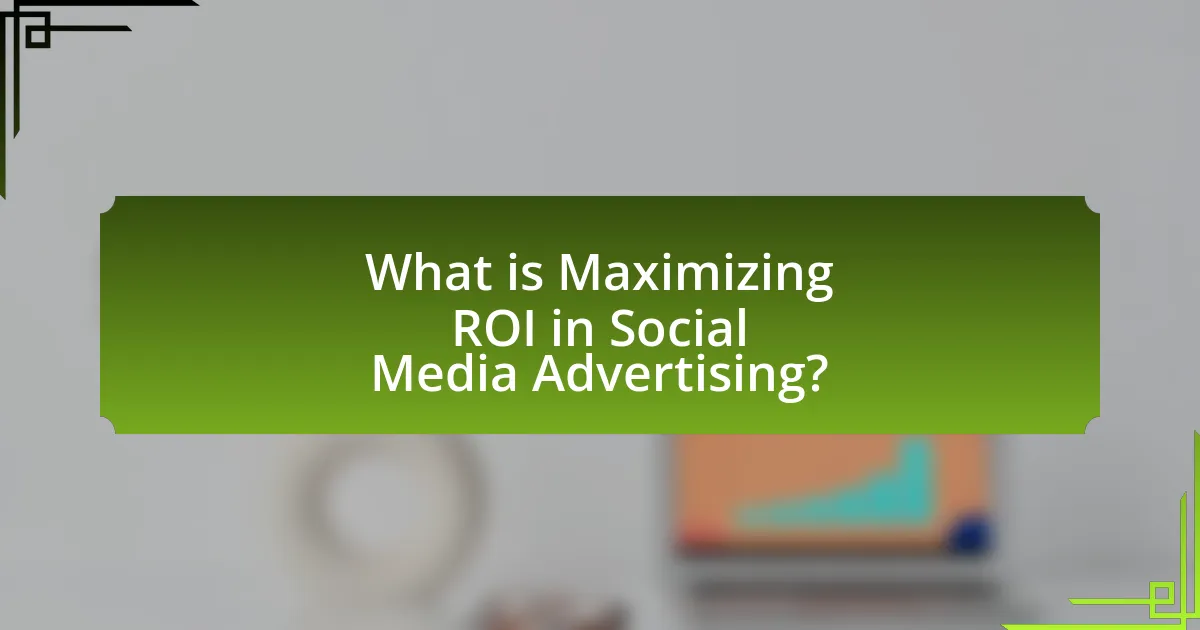
What is Maximizing ROI in Social Media Advertising?
Maximizing ROI in social media advertising refers to the process of increasing the return on investment from advertising campaigns on social media platforms. This involves optimizing ad spend, targeting the right audience, and measuring performance metrics to ensure that the financial returns exceed the costs associated with the campaigns. For instance, a study by Hootsuite found that businesses that effectively target their audience can achieve a 30% higher ROI compared to those that do not. By analyzing data and adjusting strategies based on performance, marketers can enhance their ROI, making social media advertising a more profitable endeavor.
How is ROI calculated in social media advertising?
ROI in social media advertising is calculated using the formula: (Net Profit / Cost of Investment) x 100. To determine net profit, subtract the total costs of the advertising campaign from the revenue generated through that campaign. For example, if a campaign costs $1,000 and generates $5,000 in revenue, the net profit is $4,000. Thus, the ROI would be (4,000 / 1,000) x 100, resulting in an ROI of 400%. This calculation allows businesses to assess the effectiveness of their social media advertising efforts in generating profit relative to their investment.
What metrics are essential for measuring ROI?
The essential metrics for measuring ROI in social media advertising include conversion rate, customer acquisition cost (CAC), customer lifetime value (CLV), and engagement rate. Conversion rate quantifies the percentage of users who take a desired action, directly linking advertising efforts to sales. Customer acquisition cost calculates the total cost of acquiring a new customer, providing insight into the efficiency of marketing spend. Customer lifetime value estimates the total revenue a business can expect from a customer over their relationship, helping to assess long-term profitability. Engagement rate measures interactions (likes, shares, comments) relative to total followers, indicating the effectiveness of content in driving audience interest. These metrics collectively provide a comprehensive view of the financial impact of social media advertising efforts.
How do different platforms impact ROI calculations?
Different platforms significantly impact ROI calculations by influencing audience reach, engagement rates, and conversion metrics. For instance, platforms like Facebook and Instagram typically offer advanced targeting options, which can lead to higher engagement and conversion rates, thus improving ROI. In contrast, platforms such as Twitter may have lower engagement levels but can still drive traffic effectively, affecting overall ROI differently. According to a study by HubSpot, businesses that utilize multiple social media platforms can see a 24% increase in ROI compared to those that focus on a single platform. This demonstrates that the choice of platform directly correlates with the effectiveness of advertising strategies and the resulting ROI.
Why is maximizing ROI important for businesses?
Maximizing ROI is crucial for businesses because it directly impacts profitability and sustainability. When businesses optimize their return on investment, they ensure that every dollar spent generates the highest possible revenue, which is essential for growth and competitive advantage. According to a study by the Harvard Business Review, companies that focus on maximizing ROI can achieve up to 30% higher profitability compared to those that do not prioritize this metric. This emphasis on ROI enables businesses to allocate resources more effectively, make informed strategic decisions, and ultimately enhance their market position.
What are the financial implications of a high ROI?
A high ROI indicates that an investment generates significantly more income than its cost, leading to increased profitability for businesses. This financial advantage allows companies to reinvest profits into growth opportunities, enhance cash flow, and improve overall financial stability. For instance, a study by the Harvard Business Review found that companies with a high ROI can achieve up to 30% higher growth rates compared to their competitors. Thus, the financial implications of a high ROI include enhanced profitability, increased reinvestment potential, and improved competitive positioning in the market.
How does ROI affect marketing strategies and budget allocation?
ROI directly influences marketing strategies and budget allocation by guiding decision-makers on where to invest resources for optimal returns. High ROI indicates effective strategies, prompting increased budget allocation to those channels, while low ROI leads to reevaluation or reduction of spending in less effective areas. For instance, a study by HubSpot found that businesses that track ROI are 12 times more likely to see a positive return on their marketing investments, demonstrating the critical role of ROI in shaping marketing approaches and financial planning.
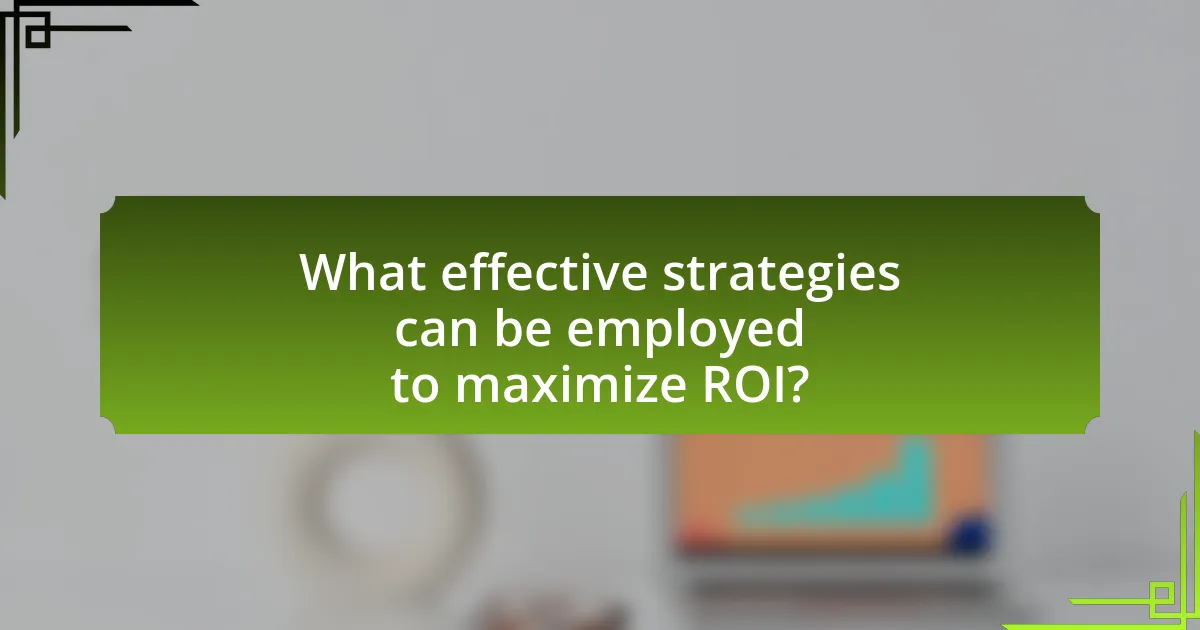
What effective strategies can be employed to maximize ROI?
To maximize ROI in social media advertising, businesses should implement targeted audience segmentation. By analyzing demographic data and user behavior, companies can tailor their ads to specific groups, increasing engagement and conversion rates. For instance, a study by HubSpot found that targeted ads can lead to a 50% increase in click-through rates compared to non-targeted ads. Additionally, utilizing A/B testing allows businesses to refine their ad content and placement, ensuring that the most effective strategies are employed. According to research from WordStream, companies that regularly test their ads can see a 20% improvement in ROI.
How can audience targeting enhance ROI?
Audience targeting enhances ROI by ensuring that marketing efforts reach the most relevant consumers, thereby increasing conversion rates. When businesses tailor their advertising to specific demographics, interests, and behaviors, they can allocate resources more efficiently, leading to higher engagement and sales. For instance, a study by the Digital Marketing Institute found that targeted ads can increase conversion rates by up to 50%, demonstrating the effectiveness of reaching the right audience. This strategic approach minimizes wasted ad spend and maximizes the potential for profitable customer interactions.
What tools are available for effective audience segmentation?
Effective audience segmentation can be achieved using tools such as Google Analytics, Facebook Audience Insights, and HubSpot. Google Analytics allows marketers to analyze website traffic and user behavior, enabling segmentation based on demographics, interests, and engagement levels. Facebook Audience Insights provides detailed information about users on the platform, including age, gender, location, and interests, which helps in creating targeted advertising campaigns. HubSpot offers a comprehensive CRM platform that includes segmentation features based on user interactions and lifecycle stages, allowing for personalized marketing strategies. These tools are widely recognized for their effectiveness in enhancing audience targeting and improving marketing ROI.
How does understanding customer behavior influence targeting?
Understanding customer behavior significantly enhances targeting by allowing marketers to tailor their strategies to meet specific needs and preferences. When businesses analyze customer behavior, they can identify patterns such as purchasing habits, preferences, and engagement levels, which inform the creation of targeted advertising campaigns. For instance, a study by McKinsey & Company found that companies that leverage customer behavior insights can increase their marketing effectiveness by up to 30%. This data-driven approach enables marketers to deliver personalized content, optimize ad placements, and improve conversion rates, ultimately maximizing return on investment in social media advertising.
What role does content quality play in maximizing ROI?
Content quality is crucial in maximizing ROI as it directly influences audience engagement and conversion rates. High-quality content attracts and retains users, leading to increased brand loyalty and higher sales. According to a study by HubSpot, companies that prioritize content marketing see conversion rates that are six times higher than those that do not. This demonstrates that investing in quality content not only enhances user experience but also significantly boosts financial returns.
How can engaging content improve conversion rates?
Engaging content can significantly improve conversion rates by capturing the audience’s attention and fostering a connection that encourages action. When content resonates with users, it increases their likelihood of interacting with the brand, leading to higher engagement metrics such as shares, likes, and comments. According to a study by HubSpot, companies that prioritize content marketing experience conversion rates six times higher than those that do not. This correlation is attributed to engaging content’s ability to build trust and establish authority, which are critical factors in the decision-making process for potential customers.
What types of content are most effective for social media advertising?
Visual content, particularly videos and images, is the most effective type of content for social media advertising. Research indicates that posts with visuals receive 94% more views than those without, significantly increasing engagement rates. Additionally, video content is projected to account for 82% of all consumer internet traffic by 2022, highlighting its importance in capturing audience attention. Furthermore, user-generated content fosters authenticity and trust, leading to higher conversion rates. Brands that leverage these types of content can maximize their return on investment in social media advertising.
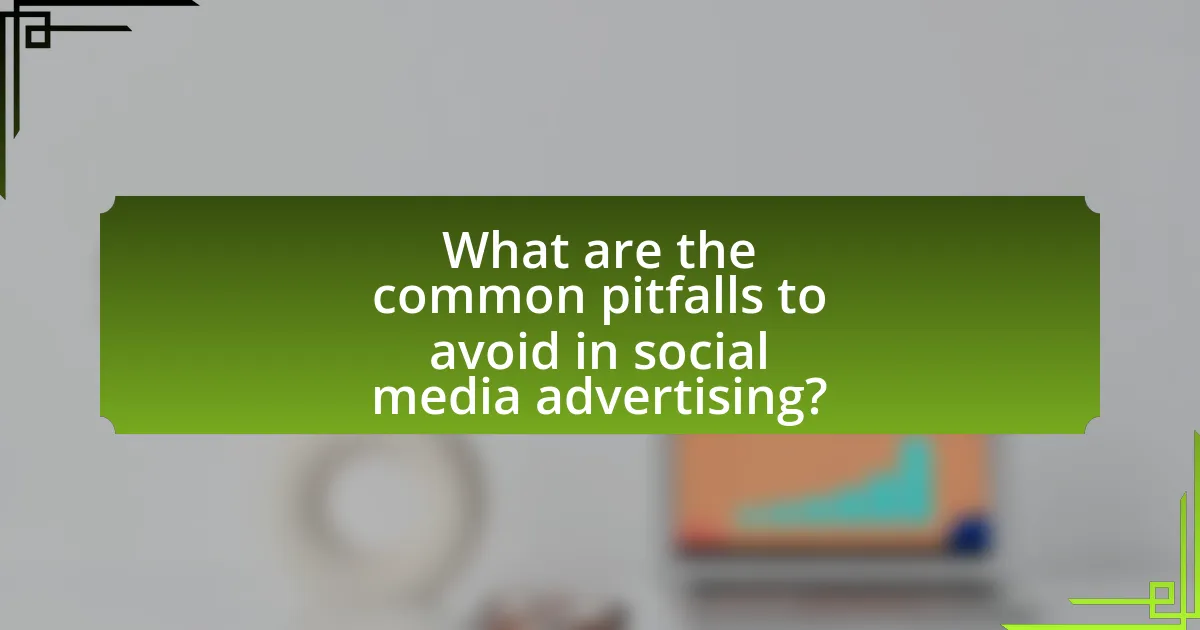
What are the common pitfalls to avoid in social media advertising?
Common pitfalls to avoid in social media advertising include targeting the wrong audience, neglecting to analyze performance metrics, and failing to create engaging content. Targeting the wrong audience can lead to wasted ad spend, as ads may not reach individuals interested in the product or service. Neglecting performance metrics prevents advertisers from understanding what works and what doesn’t, hindering optimization efforts. Additionally, failing to create engaging content results in low interaction rates, which can diminish brand visibility and effectiveness. According to a study by HubSpot, 70% of marketers say that relevant content is the most effective way to engage an audience, highlighting the importance of content quality in social media advertising.
How can poor targeting negatively impact ROI?
Poor targeting can significantly reduce ROI by directing marketing efforts towards audiences that are unlikely to convert. When advertisements reach irrelevant users, the likelihood of engagement diminishes, leading to wasted ad spend. For instance, a study by WordStream found that businesses can lose up to 30% of their marketing budget due to ineffective targeting. This misallocation of resources results in lower conversion rates and ultimately diminishes the overall return on investment.
What are the signs of ineffective audience targeting?
Ineffective audience targeting is indicated by low engagement rates, such as minimal likes, shares, or comments on social media posts. This lack of interaction suggests that the content is not resonating with the intended audience. Additionally, high bounce rates on landing pages can signal that visitors are not the right fit, as they leave quickly without taking action. Furthermore, low conversion rates, where few users complete desired actions like purchases or sign-ups, demonstrate that the targeted audience is not aligned with the product or service being offered. These signs collectively highlight the misalignment between the marketing message and the audience’s interests or needs.
How can businesses rectify targeting mistakes?
Businesses can rectify targeting mistakes by analyzing performance data to identify misaligned audience segments. This involves using analytics tools to assess engagement metrics, conversion rates, and demographic information, allowing businesses to pinpoint which segments are underperforming. For instance, a study by HubSpot found that companies that regularly analyze their audience data can improve their targeting accuracy by up to 30%. By adjusting their targeting parameters based on these insights, businesses can realign their advertising efforts to reach the most relevant audience, thereby maximizing their return on investment in social media advertising.
What mistakes in content strategy can lead to wasted ad spend?
Mistakes in content strategy that can lead to wasted ad spend include targeting the wrong audience, failing to align content with user intent, and neglecting data analysis. Targeting the wrong audience results in ads reaching individuals who are not interested in the product, leading to low engagement and high costs. For instance, a study by Wordstream found that poorly targeted ads can waste up to 76% of a marketing budget. Failing to align content with user intent means creating material that does not resonate with the audience’s needs, which can diminish ad effectiveness. Additionally, neglecting data analysis prevents marketers from optimizing campaigns based on performance metrics, resulting in continued spending on ineffective strategies. According to HubSpot, companies that analyze their data effectively can improve their ROI by up to 20%.
How can businesses assess the effectiveness of their content strategy?
Businesses can assess the effectiveness of their content strategy by analyzing key performance indicators (KPIs) such as engagement rates, conversion rates, and audience growth. Engagement rates, which include likes, shares, and comments, indicate how well the content resonates with the audience. Conversion rates measure the percentage of users who take a desired action, such as signing up for a newsletter or making a purchase, directly reflecting the content’s impact on business goals. Audience growth shows the increase in followers or subscribers over time, demonstrating the content’s ability to attract new customers. According to a HubSpot report, companies that regularly analyze these metrics can improve their content strategies by up to 30%, leading to higher ROI in social media advertising efforts.
What adjustments can be made to improve content performance?
To improve content performance, marketers should optimize content for target audiences by analyzing engagement metrics and adjusting messaging accordingly. This involves using data analytics tools to identify which types of content resonate most with specific demographics, allowing for tailored content creation. For instance, a study by HubSpot found that personalized content can increase engagement rates by up to 202%. Additionally, incorporating SEO best practices, such as keyword optimization and meta descriptions, can enhance visibility and drive organic traffic. Research from Moz indicates that effective SEO can lead to a 14.6% conversion rate compared to 1.7% for outbound leads. Regularly updating content to reflect current trends and audience interests also plays a crucial role in maintaining relevance and performance.
What best practices should be followed for maximizing ROI?
To maximize ROI in social media advertising, businesses should focus on targeted audience segmentation, data-driven decision-making, and continuous performance optimization. Targeted audience segmentation ensures that ads reach the most relevant users, increasing engagement and conversion rates. Data-driven decision-making involves analyzing metrics such as click-through rates and conversion rates to refine strategies and allocate budgets effectively. Continuous performance optimization includes A/B testing ad creatives and adjusting bidding strategies based on real-time data, which has been shown to improve ROI by up to 30% in various campaigns.
How can A/B testing be utilized to enhance advertising effectiveness?
A/B testing can enhance advertising effectiveness by allowing marketers to compare two versions of an advertisement to determine which one performs better. This method involves splitting the audience into two groups, where one group sees version A and the other sees version B. By analyzing metrics such as click-through rates, conversion rates, and engagement levels, marketers can identify which version resonates more with the target audience. For instance, a study by Optimizely found that A/B testing can lead to conversion rate improvements of up to 49%. This data-driven approach enables advertisers to make informed decisions, optimize their campaigns, and ultimately maximize return on investment.
What are the key performance indicators to monitor regularly?
Key performance indicators (KPIs) to monitor regularly in social media advertising include engagement rate, click-through rate (CTR), conversion rate, return on ad spend (ROAS), and cost per acquisition (CPA). Engagement rate measures the level of interaction (likes, shares, comments) relative to total followers, indicating content effectiveness. CTR assesses the percentage of users who click on an ad after seeing it, reflecting ad appeal. Conversion rate tracks the percentage of users completing desired actions, such as purchases, showing campaign success. ROAS calculates revenue generated for every dollar spent on advertising, providing insight into profitability. CPA measures the cost incurred to acquire a customer, helping evaluate budget efficiency. Regularly monitoring these KPIs enables businesses to optimize their social media advertising strategies and maximize ROI.
